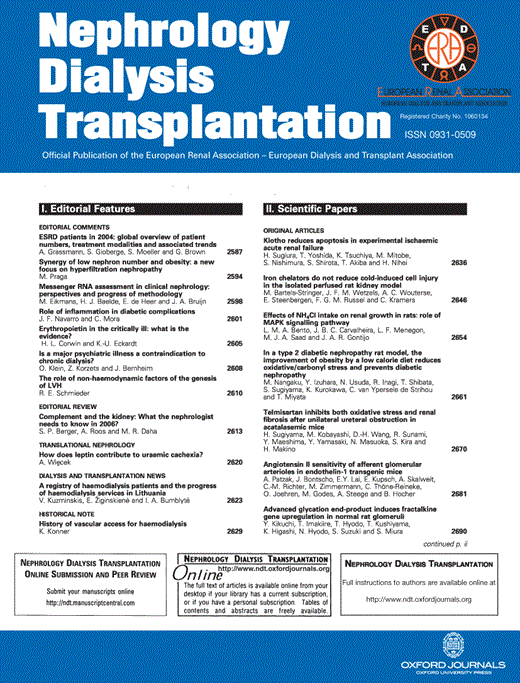-
PDF
- Split View
-
Views
-
Cite
Cite
Lorenzo A. Calò, Paul A. Davis, Andrea Semplicini, Achille C. Pessina, l-Carnitine and erythropoiesis: relationship with haeme oxygenase-1, Nephrology Dialysis Transplantation, Volume 20, Issue 8, August 2005, Pages 1769–1770, https://doi.org/10.1093/ndt/gfh934
Close - Share Icon Share
Sir,
In the May issue of Nephrology Dialysis Transplantation, Kitamura et al. [1] reported that l-carnitine increased the number of colony-forming unit-erythroid (CFU-E) colonies in mouse bone marrow cell cultures, suggesting that l-carnitine stimulates erythropoiesis, and thereby improves renal anaemia. Recent personal results obtained in vitro in endothelial cells in culture [2] and ex vivo in chronic haemodialysis patients [3] provide additional support for their findings.
It is well recognized that a reduction in erythropoiesis due to a decrease in renal erythropoietin (EPO) production, shortened erythrocyte (RBC) lifespan, and induction of oxidative stress and apoptosis are important causes of renal anaemia in patients with HD or end-stage renal disease (ESRD) [4]. l-carnitine has been shown to prolong RBC lifespan and to be beneficial in the treatment of anaemia in animal and human studies including haemodialysis patients. Antioxidant and antiapoptotic effects of l-carnitine have also been described and the elucidation of carnitine-mediated actions on erythropoiesis is ongoing. Of direct relevance to the report of Kitamura et al. [1] is our recent demonstration that the incubation of human endothelial cells in culture with l-carnitine and its acyl derivatives increased both haeme oxygenase-1 (HO-1) mRNA and protein expression [2]. HO-1 is a phase II enzyme induced by oxidative stress [4] and has been shown to possess potent antioxidant and antiapoptotic activity [5]. HO-1 expression in response to oxidative stress is regulated at transcriptional level by phosphatidylinositol 3-kinase (PI3K)/Akt pathway [6]. Interestingly, the antiapoptotic action of EPO, which occurs via EPO-mediated inhibition of proapoptotic caspase activation and attenuation of cell death in response to oxidative stress, has been shown to be dependent on JAK2 signalling and PI3K-mediated phosphorylation of Akt which, once triggered, activates multiple targets with antiapoptotic effects. Therefore, given that both EPO and HO-1 antiapoptotic effects occur via activation of the PI3K/Akt pathway and that carnitines induce HO-1, it appears reasonable to suggest that HO-1 plays an important role in the antiapoptotic effect of both EPO and carnitines. The results of our recent human study further support the existence and in vivo relevance of the importance of HO-1 for the effects of EPO, showing that EPO treatment of chronic haemodialysis patients increased mononuclear cell HO-1 gene expression and improved plasma antioxidant levels [3]. This is in favour of a potentially important increase in antioxidant status. Moreover, the high degree of correlation between haemoglobin and HO-1 expression in our study suggests a possible direct EPO effect [3]. Finally, reports that addition of carnitine improved the response to EPO and the anaemia [7] of chronic haemodialysis patients who failed to respond to EPO and HO-1 related antiapoptotic effects suggest an association between carnitine, EPO and HO-1 pathways. Thus variety of studies, including personal work, show HO-1's interrelated roles as both an antioxidant and antiapoptotic enzyme and provide a plausible mechanism for the l-carnitine induced increment in mouse bone marrow CFU-E colonies reported by Kitamura et al. [1] as well as the effects of EPO and carnitine on haemopoietic cells in ESRD and patients.
Conflict of interest statement. None declared.
References
Kitamura Y, Satoh K, Satoh T, Takita M, Matsuura A. Effect of L-carnitine on erythroid colony formation in mouse bone marrow cells.
Calò LA, Pagnin E, Davis PA et al. Antioxidant effect of L-carnitine and its short chain esters. Relevance for the protection from oxidative stress related cardiovascular damage.
Calo LA, Stanic L, Davis PA et al. Effect of epoetin on HO-1 mRNA level and plasma antioxidants in hemodialysis patients.
Maines MD. The heme oxygenase system: a regulator of second messenger gases.
Durante W. Heme oxygenase-1 in growth control and its clinical application to vascular disease.
Martin D, Rojo AI, Salinas M et al. Regulation of heme oxygenase-1 expression through the phosphatidylinositol 3-kinase/Akt pathway and the Nrf 2 transcription factor in response to the antioxidant phytochemical carnosol.
Author notes
1Department of Clinical and Experimental Medicine Clinica Medica 4 University of Padova Italy2 Department of Internal Medicine University of California Davis, CA USA Email: renzcalo@unipd.it





Comments